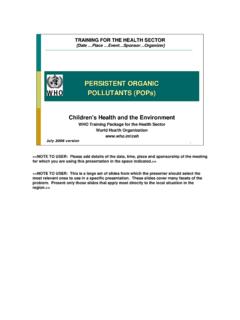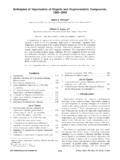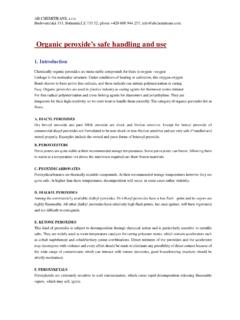Transcription of Perspective: How Organic Acids and Essential Oils …
1 Perspective: How Organic Acids and Essential Oils work together as an Alternative for Antibiotics J. P. Wang , and D. W. Chen , ,1.. Key Laboratory of Animal Disease-Resistance of China Ministry of Education, Sichuan Agricultural University, Ya'an 625014, P. R. China . Institute of Animal Nutrition, Sichuan Agricultural University, Sichuan, Ya'an 625014, P. R. China 1. Corresponding author, Daiwen, Chen Tel: +86-371-63558180. Fax: +86-835-2885106. E-mail: Summary Increasing concerns with food safety and drug-resistant pathogens have focused public attention on alternatives to antibiotics. As a result, the feed industry has also concentrated on these alternatives; amongst which, Organic Acids and Essential oils are of great potential. Both of these have been widely used as medicines or health-care agents for a long period of time. The mechanisms of Organic Acids and Essential oils have been widely studied in the literature. It is thought that they may cooperate well together in the gastrointestinal tract of the animal and possibility to enhance the health status and growth performance of the animal.
2 1. Introduction Due to the growing concern about using antibiotics in livestock feeds, it is Essential to identify alternatives to antibiotic growth promoters (AGP) in the feed industry. The current candidate replacements include Organic Acids , probiotics, prebiotics (mainly oligosaccharides and polysaccharides products), plant extracts ( Essential oils), nucleotide and enzymes, etc. Organic Acids (OA), either individual Acids or blends of several Acids , have been found to exert antimicrobial activities that are similar to antibiotics and which induce significant benefits in weanling pigs and poultry (Roth and Kirchgessner 1998;. Partanen, 2001; verland et al., 2007). Like antibiotics, Organic Acids also have a specific antimicrobial activity. Reductions in bacteria associated with feeding Organic Acids are particularly effective against acid-intolerant species such as Escherichia coli, Salmonella and Campylobacter. Organic Acids improve animal performance due to their wide ranging effects, such as; improvement of protein and energy utilization, (which may be attributed to their ability to reduce microbial competition with the host for nutrient and endogenous nitrogen loss), reduction in ammonia production and other growth-depressing microbial metabolites (in order to lower the incidence of subclinical infections), and the regulation and secretion of immune mediators (Dibner and Buttin, 2002).
3 Organic Acids have several additional effects that go beyond those of antibiotics. These include reduction in digesta pH, increase of pancreatic secretion, and trophic effects on the gastrointestinal mucosa (Dibner and Buttin, 2002). Essential oils (EO) are volatile oils obtained from plants by steam and/or water distillation. Most EO consists of mixture of hydrocarbons (terpenens, sesquiterpenes, etc.), oxygenated compounds (alcohol, esters, aldehydes, ketones, etc.) and a small percentage of non-volatile residues (paraffin, wax, etc.). Essential oils have been widely proposed as alternatives to antibiotics because of their derived benefits and growth promoting effects (Wang et al., 2007; Windisch et al., 2008; Yan et al., 2011). Essential oils have been demonstrated to increase growth performance and feed efficiency by increasing secretion of endogenous digestive enzymes, regulation of the gut microflora, immune modulation, and have anti-viral, anti-bacterial, and antioxidant properties (Geda, 1995; Helander et al.)
4 , 1998; Wenk, 2003). 2. Definition and Mechanism of Organic Acids As a group of chemicals, Organic Acids are considered to be any Organic carboxylic acid, including fatty Acids and amino Acids , of the general structure R-COOH. The most common Organic Acids are acetic, benzoic, butyric, citric, formic, lactic, malic, propionic and tartaric Acids . Their chemical structures and properties are shown in Table 1. The inclusion of OA in diets has been confirmed to have growth enhancing effects, especially in young animals. The mean improvements in growth rate were and for 0 to 2 and 0 to 4 weeks post-weaning periods, respectively (Tung and Pettigrew, 2006). Demonstrated mechanisms of Organic Acids action include: 1. decreased gastric pH to improve nutrient digestibility. Low stomach pH is capable of preventing the development of pathogenic bacteria and is favorable to digestion of proteins and other nutrients due to the low gastric pH that is required for conversion of pepsinogen to pepsin (Canibe et al.
5 , 2001; Franco et al., 2005; Koch, 2005; Wang, et al., 2009, 2010, 2011);. 2. direct killing of pathogenic bacteria. Organic Acids in undissociated form are lipophilic and can therefore diffuse across bacterial cell membranes to reach the interior of the cell to disrupt cell function (Partanen, 2001;. Dibner and Buttin, 2002). 3. The Definition and Mechanism of Essential Oils An Essential oil is a concentrated hydrophobic liquid containing volatile aroma compounds from plants (leaves, roots, tubers or fruits or herbs, spices or other plants), and they are generally prepared by fragrance extraction techniques such as distillation (steam distillation), cold pressure, or extraction. Essential oils are highly complex mixtures of hundreds of individual aroma compounds, with variable chemical compositions and concentrations (Kalemaba and Kunicka, 2003). Although EO usually vary considerably in their chemical ingredients composition, (depending on plant source and extraction technology), they can be incorporated into diets in order to enhance the performance and well-being of animals (Windisch et al.
6 , 2008). Table 2 summarizes, plant sources, main functions and possible modes of action of the EO. The function of EO include: 1. stimulating the voluntary feed intake (Lee et al., 2003; Jiang et al., 2004;. Giannenas et al., 2003; Ertas et al., 2005; Kroismayr et al., 2008; Yan et al., 2011) and the secretion of digestive enzyme (Platel and Srinivasan, 1996;. Wenk, 2003);. 2. exerting direct antimicrobial effect (especially inhibiting the growth of particularly potentially pathogenic bacteria gram ( ) bacteria, such as, E. coli O157:H7,Staphylococcus aureus) through disruption of the cell membrane by H+ bonding, rendering the membranes and mitochondria more permeable and disintegrating the outer cell membrane (Kamel, 2001a,b; Di Pasqua et al., 2007; Ouwehand et al., 2006);. 3. having anticoccidial, fungicidal or antioxidant properties (Cruickshank, 2011; Wenk, 2003); and 4. playing immunomodulatory functions (Vidanarachchi et al.
7 , 2005; Windisch et al., 2008; Wang et al., 2011). In summary, it is generally assumed that EO may stimulate peptides and production of digestive enzymes such as lipase and amylase, thus having a beneficial effect on feed intake and nutrient utilization in different groups of animals. Finally, they may exert antimicrobial, anticoccidial, fungicidal or antioxidant properties and immunomodulatory effects. 4. Possibility of Synergetic Effect between Organic Acids and Essential Oils The action mode shown above indicates that both Organic Acids and Essential oils can exert antimicrobial properties in the gastrointestinal tract via different mechanisms. There is no doubt that Organic Acids and Essential oils are capable of substantially modifying the gut microflora, which, in turn, can bring about improvement in animal performance and well-being. The modes of action by which Organic Acids and plant derived bioactive substances exert their positive effects (antimicrobial, growth-promoting, or immunomodulatory effects) have been well The different mechanisms of Organic acid and Essential oils may create the possibility to cooperate with each other in the animal and subsequently enhance the livestock.
8 As stated by Langhout (2000), a combination of Organic Acids and Essential oils would be beneficial, as the Organic Acids appear to be particularly active in the feed, crop, and gizzard, whereas Essential oils appear to work more effectively in the later segments of the intestinal tract. A combination of both products might result in a stronger product and improve the digestive process throughout the digestive tract. Weber et al. (2012) suggested that the combination of mixture of EO compounds (including thymol, eugenol and piperine) and OA (benzoic acid) increased the growth performance of broilers. EO components share something in common with Organic Acids . For example, phenols, found in EO (such as thymol, eugenol and carvacrol) are a diverse series of either single (phenolic) or multiple (polyphenolic) aromatic rings differing principally in their respective side chains. In this case, structurally similar to OA, phenolic compounds also contain non-homologous groups, varying in the numbers of carboxyl groups, hydroxyl groups and carbon-carbon double bonds at the molecular level (Kamel, 2001b; Dalia, 2012).
9 In addition, the chemical properties of bioactive substances derived from EO may also correspond to the incidence of polar groups (numbers of double bonds, molecular size, and solubility in non-polar matrices). Based on above assumption, we hypothesize that OA and EO can cooperate with each other to improve growth performance. Therefore, the application of proper combinations of certain kinds of Organic Acids and Essential oils in animal nutrition is a promising strategy for antibiotics replacement and will require further research. References: Abreu, A. C., A. J. McBain, and M. Sim es. 2012. Plants as sources of new antimicrobial and resistance-modifying agents. Nat. Prod. Rep. 29:1007-1021. Canibe, N., S. H. Steien, M. verland, and B. B. Jensen. 2001. Effect of K-diformate in starter diets on acidity, microbiota, and the amount of Organic Acids in the digestive tract of piglets, and on gastric alterations. J. Anim. Sci. 79: 2123-2133.
10 Charalambous, G. (ed.) 1994. Spices, Herbs and Edible fungi. Elsevier. London. Cruickshank, G. 2001. Botanical growth enhancers offer natural option for broiler growers. 10:19-22. Daglia, M. 2012. Polyphenols as antimicrobial agents. Current Opinion Biotech. 23:174-181. Dibner, J. J., and P. Buttin. 2002. Use of Organic acid as a model to study the impact of gut microflora on nutrition and metabolism. J. Appl. Poult. Res. 11:453-463. Di Pasqua, R., G. Betts, N. Hoskins, M. Edwards, D. Ercolini, G. Mauriello. 2007. Membrane toxicity of antimicrobial compounds from Essential oils. J. Agric. Food Chem. 55:4863-4870. Franco, L. D., M. Fondevila, M. B. Lobera, and C. Castrillo. 2005. Effect of combinations of Organic Acids in weaned pig diets on microbial species of digestive tract contents and their response on digestibility. J. Anim. Physiol. Anim. Nutr. 89, 88-93. Geda, (1995). Antibacterial activity of Essential oils and their combinations.








